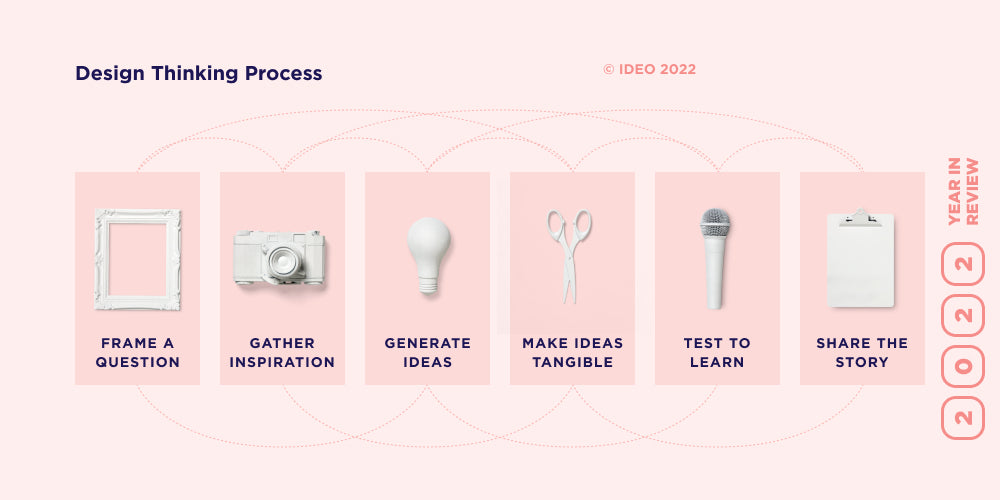
Frameworks can be useful tools for approaching design thinking, strategy, and systems design. Here are some of our commonly used frameworks that we practice and teach in our online IDEO U courses.
Design Thinking Frameworks

Our design thinking framework takes a human-centered approach to innovation that starts with what is desirable from a human point of view, along with what is technologically feasible and economically viable. There are 6 phases in the design thinking process:
- Frame a question
- Gather inspiration
- Generate ideas
- Make ideas tangible
- Test to learn
- Share the story
We teach the phases of design thinking as linear steps, but in practice the process is not always linear. Some of the phases may happen several times, and you may move back and forth between them.
Read more design thinking articles, activities, and case studies on our list of design thinking resources.
3 Elements of Design Thinking

There are many design thinking frameworks and tools, but there are 3 mindsets you’ll always find when using a design thinking approach. These are the core elements of design thinking:
- Inspiration — Connecting with people to understand their needs
- Ideation — Creative thinking and diverging to generate ideas
- Experimentation — Prototyping, making tangible, and iterating
Practice the core skills and mindsets of design thinking in our popular online certificate Foundations in Design Thinking.
Strategy Frameworks
Strategy Process Map

In our Designing Strategy course, we define strategy as the act of making choices under uncertainty and competition. The strategy process map, a framework from the course, guides you through the process of creating a winning strategy and helps you avoid getting lost in ambiguity and complexity. With a strategy process map, you:
- Identify the problem
- Frame a strategic question
- Generate possibilities
- Think about what would have to be true
- Understand barriers
- Conduct tests
- Choose a strategic direction
4 Types of Strategy Stakeholders

When implementing strategy, it’s important to collaborate effectively with different stakeholders. As you’re identifying stakeholders, ask yourself two key questions:
- Who are the players that need to be involved?
- What role do they need to play?
While answering these two questions, think about the following categories:
- Core Team: Does the work of strategy
- Extended Team: Are critical to bringing the strategy to life
- Subject Matter Experts: Hold expertise needed to build, test, or activate the strategy
- Sponsors: Must approve the strategy, and their support is important to its success
This will set you up to define a plan for when and how to engage those stakeholders. Learn more about engaging stakeholders in the strategy creation process in our Activating Strategy online course.
5 Elements of Strategy Action Plans

To bring strategy to life, every part of an organization needs to be engaged in the process. There are 5 key elements in any strategy action plan:
- Resources: Allocate resources and create financial guardrails
- People: Staff teams to have a diverse mix of talent
- Information Flows: Leverage internal communications infrastructure to ensure teams have access to the right information
- Decision Spaces: Clarify where teams have (or do not have) the ability to make decisions
- Measures: Align on what success looks like in the short, medium, and long term
Deepen your understanding of strategy creation and implementation in our online course, Activating Strategy.
Systems Design Frameworks
Iceberg Model

In a complex system, solving problems requires considering the whole picture and surfacing the root of the problem. The iceberg model is a framework for uncovering the layers of a system. It helps you:
- Look for patterns over time, starting with what you see
- Uncover deeper structural influences
- Surface underlying mindsets
To learn about the iceberg model in more detail, check out our online course Human-Centered Systems Thinking.

A systems map is a tool commonly used by systems designers to lay out all the relationships and interactions between stakeholders in a given system—for example, a local high school as shown in the above image. Mapping systems can help you spot opportunities for growth and change.
Try these steps to create a systems map:
- Write down every stakeholder in your system on a blank piece of paper. Push yourself to think past the obvious.
- Draw arrows between the different parts of your system to identify how they’re connected.
- Reflect on what specific areas you want to examine more closely. What questions come up for you? What gaps do you see?
It’s helpful to work with a partner or group when creating systems maps to start to get a more holistic view of the system. Explore more frameworks with these systems thinking resources.
Advance Your Design Thinking Skills with IDEO U Courses
By integrating these powerful design thinking frameworks, you can transform your problem-solving skills and drive impactful results. Ready to improve your skills? IDEO U offers a range of online courses and certificates designed to deepen your expertise and equip you with the tools needed to tackle unique challenges more effectively.
Stay up-to-date with the latest frameworks from IDEO U by following us on Instagram (@ideo_u).
- choosing a selection results in a full page refresh
- press the space key then arrow keys to make a selection



